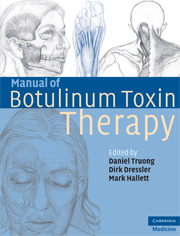Book contents
- Frontmatter
- Contents
- List of contributors
- Foreword – Alan B. Scott
- Preface
- 1 The pretherapeutic history of botulinum toxin
- 2 Botulinum toxin: history of clinical development
- 3 Pharmacology of botulinum toxin drugs
- 4 Immunological properties of botulinum toxins
- 5 Treatment of cervical dystonia
- 6 Treatment of hemifacial spasm
- 7 Treatment of blepharospasm
- 8 Treatment of oromandibular dystonia
- 9 Treatment of focal hand dystonia
- 10 Botulinum toxin applications in ophthalmology
- 11 Botulinum toxin therapy of laryngeal muscle hyperactivity syndromes
- 12 The use of botulinum toxin in otorhinolaryngology
- 13 Spasticity
- 14 The use of botulinum toxin in spastic infantile cerebral palsy
- 15 Hyperhidrosis
- 16 Cosmetic uses of botulinum toxins
- 17 Botulinum toxin in the gastrointestinal tract
- 18 Botulinum toxin in urological disorders
- 19 Use of botulinum toxin in musculoskeletal pain and arthritis
- 20 The use of botulinum toxin in the management of headache disorders
- 21 Treatment of plantar fasciitis with botulinum toxin
- 22 Treatment of stiff-person syndrome with botulinum toxin
- 23 Botulinum toxin in tic disorders and essential hand and head tremor
- 24 Developing the next generation of botulinum toxin drugs
- Index
- References
11 - Botulinum toxin therapy of laryngeal muscle hyperactivity syndromes
Published online by Cambridge University Press: 28 July 2009
- Frontmatter
- Contents
- List of contributors
- Foreword – Alan B. Scott
- Preface
- 1 The pretherapeutic history of botulinum toxin
- 2 Botulinum toxin: history of clinical development
- 3 Pharmacology of botulinum toxin drugs
- 4 Immunological properties of botulinum toxins
- 5 Treatment of cervical dystonia
- 6 Treatment of hemifacial spasm
- 7 Treatment of blepharospasm
- 8 Treatment of oromandibular dystonia
- 9 Treatment of focal hand dystonia
- 10 Botulinum toxin applications in ophthalmology
- 11 Botulinum toxin therapy of laryngeal muscle hyperactivity syndromes
- 12 The use of botulinum toxin in otorhinolaryngology
- 13 Spasticity
- 14 The use of botulinum toxin in spastic infantile cerebral palsy
- 15 Hyperhidrosis
- 16 Cosmetic uses of botulinum toxins
- 17 Botulinum toxin in the gastrointestinal tract
- 18 Botulinum toxin in urological disorders
- 19 Use of botulinum toxin in musculoskeletal pain and arthritis
- 20 The use of botulinum toxin in the management of headache disorders
- 21 Treatment of plantar fasciitis with botulinum toxin
- 22 Treatment of stiff-person syndrome with botulinum toxin
- 23 Botulinum toxin in tic disorders and essential hand and head tremor
- 24 Developing the next generation of botulinum toxin drugs
- Index
- References
Summary
Introduction
Spasmodic dysphonia is a focal dystonia characterized by task-specific, action-induced spasm of the vocal cords. It adversely affects the patient's ability to communicate. It can occur independently, as part of cranial dystonia (Meige's syndrome), or in other disorders such as in tardive dyskinesia.
Clinical features
There are three types of spasmodic dysphonia: the adductor type, the abductor type, and the mixed type.
Adductor spasmodic dysphonia (ADSD) is characterized by a strained-strangled voice quality and intermittent voice stoppage or breaks due to overadduction of the vocal folds, resulting in a staccato-like voice.
Abductor spasmodic dysphonia (ABSD) is characterized by intermittent breathy breaks, associated with prolonged abduction folds during voiceless consonants in speech.
Patients with the mixed type have presentations of both.
Symptoms of spasmodic dysphonia begin gradually over several months to years. The condition typically affects patients in their mid 40s and is more common in women (Adler et al., 1997; Schweinfurth et al., 2002).
Spasmodic dysphonia may coexist with vocal tremor. Patients with ADSD show evidence of phonatory breaks during vocalization. The vocal breaks typically occur during phonation associated with voiced speech sounds (Sapienza et al., 2000).
Stress commonly exacerbates speech symptoms; while they are absent during laughing, throat clearing, coughing, whispering, humming, and falsetto speech productions (Aronson et al., 1968). The voice tends to improve when the patient is emotional.
Treatment options for ADSD
The efficacy of botulinum toxin in the treatment of spasmodic dysphonia has been proven in a double-blind study (Truong et al., 1991).
- Type
- Chapter
- Information
- Manual of Botulinum Toxin Therapy , pp. 85 - 92Publisher: Cambridge University PressPrint publication year: 2009

